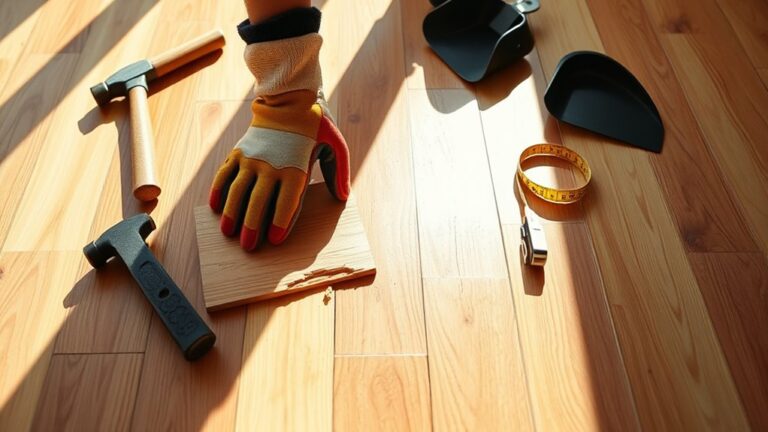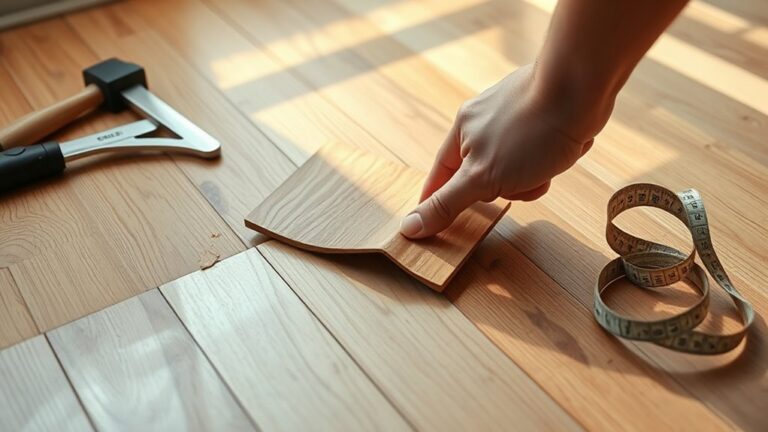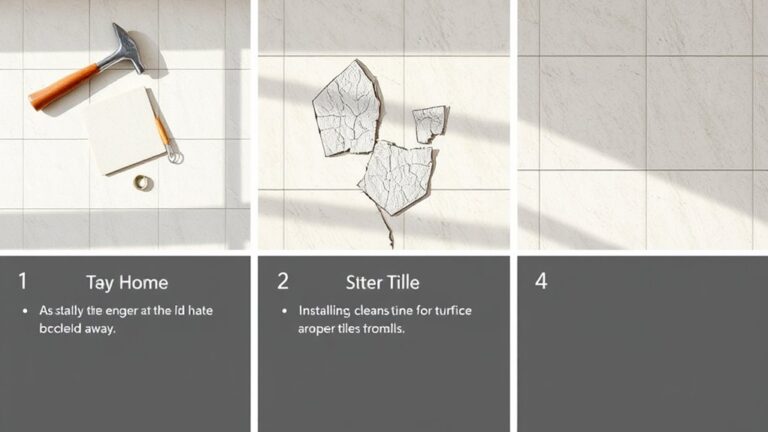To maintain different types of flooring effectively, tailor your approach to the material. For hardwood, sweep weekly and use a damp mop with pH-neutral cleaner, addressing spills immediately. Vacuum carpets weekly, treat stains promptly, and deep clean bi-annually. Tile requires regular sweeping and mild detergents; seal grout to protect against staining. For vinyl and laminate, sweep often and use non-abrasive cleaners while controlling moisture. Regular maintenance not only enhances your flooring's appearance but also prevents costly damage over time. By following these practices, you'll discover even more strategies to guarantee your floors stay in top condition.
Cleaning Hardwood Floors
When it comes to cleaning hardwood floors, it's important to adopt a systematic approach to preserve their beauty and longevity. Regular maintenance is essential to avoid dirt accumulation and scratches. Start by sweeping or vacuuming your hardwood floors at least once a week. Use a soft-bristle attachment on your vacuum to prevent damaging the surface while effectively removing debris.
In addition to regular cleaning, addressing spills immediately is critical. Wood is sensitive to moisture, so blotting spills with a cloth can help prevent staining and potential water damage. When mopping, use a damp mop along with a pH-neutral hardwood floor cleaner. Excessive water can warp the wood, so make sure your mop is only slightly damp.
To further maintain your hardwood floors, consider placing doormats at entryways and area rugs in high-traffic zones. These simple additions can greatly reduce dirt and scratches, keeping your floors looking pristine. It's also wise to schedule professional refinishing every 3-5 years. This process restores the floor's appearance and provides a protective layer against wear and tear, making sure your investment lasts.
Maintaining Carpet Flooring
Although maintaining carpet flooring can seem intimidating, adopting a structured cleaning routine can greatly enhance its longevity and appearance. Regular vacuuming at least once a week is essential to remove loose dirt and allergens from carpet fibers. This not only helps in maintaining a clean and healthy indoor environment but also prevents dirt from embedding deeper into the fibers.
When accidents happen, address stains immediately using appropriate stain removers. This quick action can prevent permanent discoloration and damage, preserving your carpet's aesthetic. For a more thorough approach, consider deep cleaning with steam cleaners or hiring professional cleaning services every 6-12 months. This process effectively eliminates embedded dirt and refreshes the carpet's look.
To protect your investment, implement carpet protectors in high-traffic areas. These not only reduce wear and tear but also extend the carpet's lifespan considerably. Additionally, periodically rotating your furniture placement can help prevent indentations and uneven wear patterns, promoting an even appearance over time.
Care for Tile Flooring
Maintaining tile flooring requires a systematic approach to secure its durability and visual appeal. By following a few best practices, you can guarantee your tile floors remain in excellent condition:
- Regularly sweep or vacuum to prevent scratches.
- Use mild detergents for safe cleaning.
- Address stubborn stains promptly to avoid them becoming permanent.
- Schedule deep cleaning every 12-18 months.
To start, it's vital to regularly sweep or vacuum your tile flooring to remove loose dirt and debris. This step is essential as neglecting it can lead to scratches on the tile surface. When it's time to clean tile floors, stick to mild detergents or specialized tile cleaners. Avoid harsh chemicals that could damage the finish.
For stubborn stains or issues with grout, you can create a paste of baking soda and water. This mixture can effectively lift stains without harming your tiles. Additionally, sealing your grout periodically will help prevent staining and moisture penetration, which can lead to damaged grout lines.
When cleaning, remember to use a damp mop rather than excessive water. Too much moisture can harm your grout lines. Deep cleaning should be performed every 12-18 months to maintain cleanliness and prolong the lifespan of your flooring. By following these practices, you'll keep your tile flooring looking its best while enjoying the freedom of a beautiful and well-maintained space.
Vinyl and Laminate Maintenance
Vinyl and laminate flooring requires attentive care to guarantee long-lasting beauty and functionality. To maintain these surfaces, regular cleaning is essential. Sweep or vacuum your floors frequently to prevent dirt and grit buildup, which can lead to scratches and dullness. For cleaning, use warm water and non-abrasive cleaners, avoiding excessive moisture to prevent warping and damage.
When accidents happen, make sure to wipe up spills immediately. This prevents staining and moisture penetration, which can compromise the integrity of your vinyl and laminate flooring. To further protect your laminate surfaces, use felt pads under furniture legs. These pads minimize scratches and indentations, ensuring smooth movement without causing damage.
Humidity control is also important for maintaining both vinyl and laminate flooring. Excessive moisture can lead to warping, so try to keep the humidity levels in your home stable. Additionally, scheduling periodic deep cleaning every 18-24 months will help maintain the appearance and prolong the lifespan of your flooring. A thorough deep clean removes built-up dirt and grime that regular cleaning might miss.
Importance of Regular Maintenance
Regular maintenance of your flooring is essential for preserving its integrity and appearance over time. By committing to a routine care schedule, you can greatly extend the lifespan of your floors—studies indicate that consistent maintenance can increase longevity by up to 50%. Here are some key benefits of regular upkeep:
- Helps prevent damage that could lead to costly repairs
- Reduces the risk of safety hazards like slips and falls
- Fosters a healthier indoor environment by minimizing allergens
- Enhances the aesthetic appeal and overall property value
Neglecting regular maintenance can result in the accumulation of dirt and untreated stains, necessitating professional restoration, which can be financially burdensome. Regular inspections and upkeep not only mitigate risks associated with deteriorating flooring but also promote a safer home environment, especially for families with children and pets.
Furthermore, implementing a maintenance schedule based on foot traffic allows you to address specific wear and tear, ensuring your floors remain well-maintained. This proactive approach not only enhances the aesthetic appeal of your property but also serves as a key selling point in the real estate market. Ultimately, investing time and effort into maintaining your floors is an investment in your home's value and your family's safety, creating a space that feels welcoming and looks pristine.
Frequently Asked Questions
Is It OK to Have 3 Different Types of Flooring?
Yes, it's perfectly fine to have three different types of flooring, as long as you consider flooring shifts for smooth changes between areas. Aim for aesthetic cohesion by matching colors and styles to maintain design flow. Think about room functionality too; durable materials work well in high-traffic spaces. However, be mindful of maintenance challenges and noise considerations. Done right, this can enhance your home's resale value while ensuring style consistency throughout.
What Type of Flooring Requires the Least Maintenance?
If you're looking for flooring that requires the least maintenance, luxury vinyl and laminate flooring are your best bets. They resist moisture, scratches, and stains, allowing for simple upkeep with regular sweeping and damp mopping. Unlike carpet maintenance, which demands frequent vacuuming and deep cleaning, or tile care needing grout cleaning, vinyl and laminate offer convenience. You'll appreciate their durability and low maintenance needs, freeing you up for more enjoyable pursuits.
Is It Okay to Have Different Flooring in Each Room?
Is it really okay to have different flooring in each room? Absolutely, if you consider flooring changes and color coordination. You can achieve aesthetic harmony while enhancing room functionality through texture contrast. Just guarantee design consistency and sound absorption are maintained. Keep maintenance considerations and cost implications in mind, too. Ultimately, it's about your personal preference; different flooring can create a unique flow that adds character to your home without feeling disjointed.
How Many Different Types of Flooring Should a House Have?
When deciding how many different flooring styles your house should have, consider aesthetic harmony and room changes. Aim for two to three compatible materials that allow for color coordination and temperature regulation. Think about durability factors and acoustic considerations, especially in high-traffic areas. Cost implications and installation techniques also play roles in your decision. Balancing these aspects will help you create a cohesive and functional living space that meets your needs.




